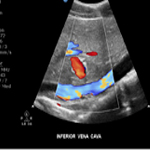Abdominal Ultrasound

When performing an abdominal ultrasound, reflected sound waves are produced, which create a picture of the organs and structures in the upper abdomen. Sometimes a specialized ultrasound is needed to obtain the detailed evaluation of a specific organ. In such cases, an abdominal ultrasound can be very useful in determining whether further more invasive testing is needed. The following structures and organs can be evaluated in an Abdominal Ultrasound:
Abdominal ultrasound is done to:
-
Abdominal aorta, which is the large artery (blood vessel) in the body. The Aorta passes down through the the chest and abdomen and supplies blood to the lower part of the body including the legs.
-
Liver, which is a large domed shaped organ that sits under the ribs on the right side of the abdomen. The liver produces bile which helps digest fat, stores sugars, and breaks down many of the waste products in the body.
-
Gallbladder, which is a small organ situated beneath the liver. The gallbladder stores bile and when food is eaten the gallbladder contracts, sending bile into the intestines to help digest food. The Gallbladder also helps in the absorption of fat soluble vitamins.
-
Spleen, which is located to the left of the stomach, just behind the ribs. The spleen is a soft, round organ that filters old red blood cells and helps fight infection.
-
Pancreas, which is located in the upper abdomen and produces enzymes that help digest food. The pancreas also releases insulin into the bloodstream; helping the body utilize sugars for energy.
-
Kidneys, which are a pair of bean shaped organs situated in the back of the upper abdominal cavity. The kidneys process wastes from the bloodstream, and produce urine.

Abdominal ultrasound is done to:
-
Detect, measure and monitor an aneurysm in the aorta. An aneurysm is an enlargement of the Aorta that needs to be monitored to determine if and when surgical intervention is necessary.
-
Determine the reason for abdominal pain.
-
Evaluate abnormal liver function tests and the shape, size, and position of the liver. An ultrasound may be done to evaluate liver masses, jaundice and other problems of the liver, including fatty deposits in the liver and cirrhosis.
-
Detect cholecystitis, an inflammation of the gallbladder, gallstones and blocked bile ducts.
-
Detect kidney stones.
-
Evaluate an enlarged spleen to look for damage or disease.
-
Detect pancreatitis or pancreatic cancer.
-
A kidney ultrasound may be done to detect kidney masses, fluid surrounding the kidneys and to measure the size of the kidneys. It can also help determine the cause of reduced urine flow and the reason for recurring urinary tract infections, or UTI’s. A kidney ultrasound can also be used to evaluate the condition of transplanted kidneys.
-
Determine whether a mass in any of the abdominal organs such as the kidneys liver are a solid tumor or a fluid filled cyst.
-
Evaluate the condition of abdominal organs after an accident or abdominal injury or detect blood in the abdominal cavity. Computed tomography (CT) scanning is sometimes used for this purpose, since it is more precise than an abdominal ultrasound.
-
Assist in the performance of a biopsy by helping to guide the placement of a needle or other instrument during the procedure.
-
Detect peritoneal cavity fluid and the reason for the buildup of fluid in the abdominal cavity. An ultrasound also may be performed to guide the needle during a procedure called paracentesis, which is done to remove fluid from the abdominal cavity.
